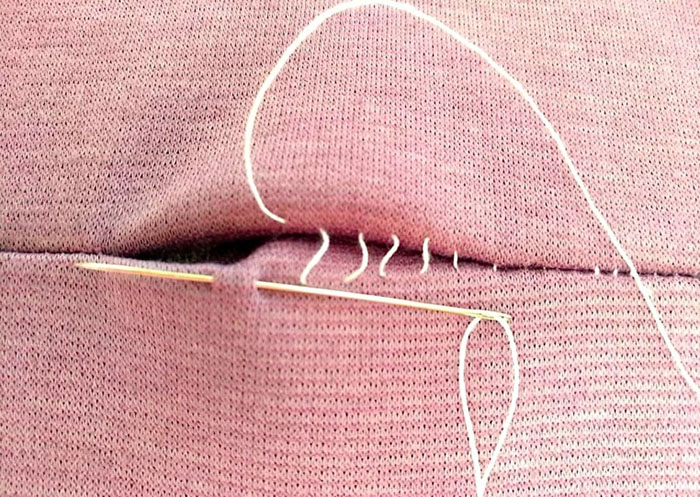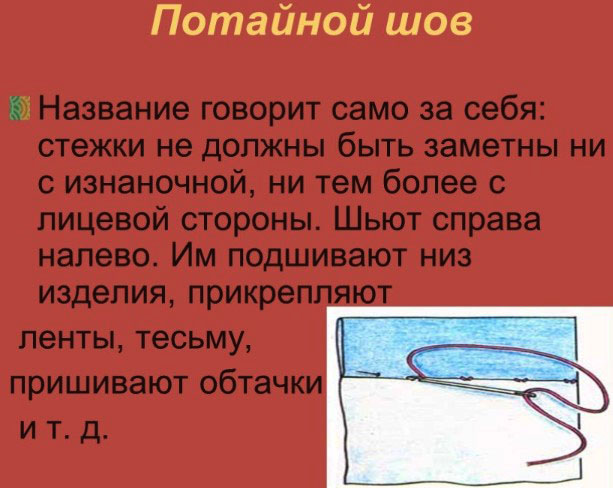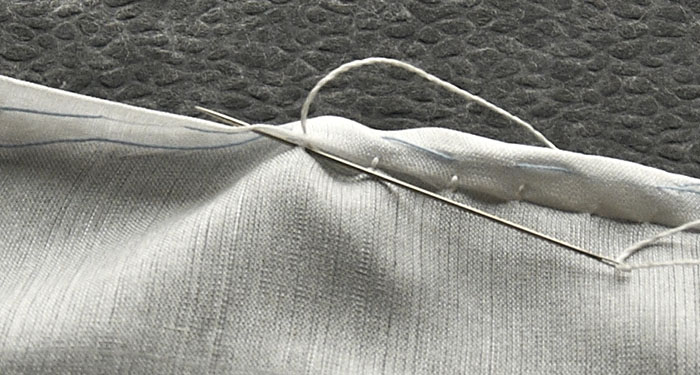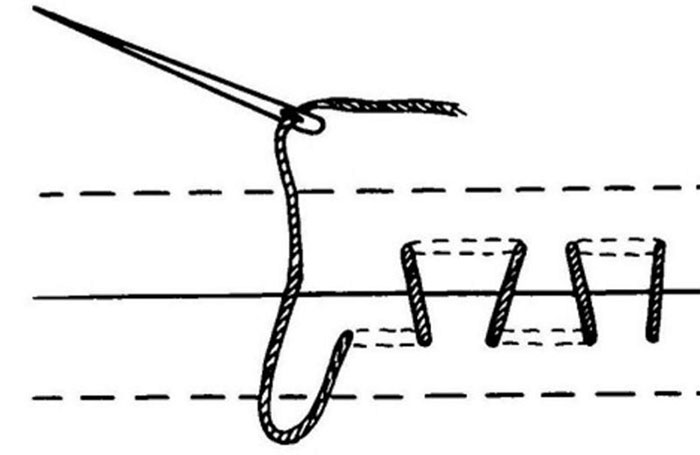Blind stitch can be done on a machine, but it is better to learn how to do it manually using a thread and a needle. Photos and step-by-step recommendations for its implementation are presented later in the article.
What is a blind stitch?
A blind stitch is also called invisible. Its purpose is to invisibly connect two pieces of fabric.
The technique of making a blind seam is very simple. The main requirement for its execution is accuracy. From the front side, the item should look like it was sewn on a machine.
Features of a blind seam
The peculiarity of the seam is that it is actually there, but it is not visible. The effect of invisibility is achieved with practice. To begin with, fabrics with pronounced textures are used, where the weaving threads are visible. This can be cotton, linen, woolen fabric.
There are 2 ways to use a blind stitch:
- For hemming the garment (inner blind stitch). In this case, you need to sew so that the stitches are not visible from the front side. The stitches vary in length, and on the face fabric the needle only catches 1-2 threads.

- To connect two parts (face blind seam). The edges of the parts are folded to the wrong side, the thread is passed through the folds of the parts. If the color of the thread is chosen exactly to match the tone of the product, the seam becomes almost invisible. The stitches on both sides are equal in length.
Where is it used?
A blind stitch by hand (step-by-step photos are provided later in the article) is easy to make. It has several purposes. The main function is to connect two parts.
The main types of application of the blind stitch are described in the table:
| Where is it used? | Blind stitch type |
| Clothing repair (sewing up holes, cuts, torn seams) | Facial Connector |
| Making toys (sewing on parts of arms, legs, head, ears, stitching seams) | Facial Connector |
| Hemming (jeans, trousers, skirts, blouses) | Purl lining |
| Making clothes (sewing on sleeves, lining) | Facial Connector |
| Manufacturing of items using patchwork and quilling techniques (hemming the edges of the item, processing decorative elements) | Purl lining |
How to make a perfect invisible seam by hand?
To learn how to make a blind stitch, you need to have the right threads, needles and follow the basic rules for doing it.
Secrets of the perfect blind stitch:
- Work must be performed in comfortable conditions with good lighting.
- The working thread is selected close in color to the fabric of the product. If it is not possible to choose a color, then for dark fabrics take a black thread, and for light ones - a white one.
- The needle is thin, sharp, short with a small eye.
- The edges of the sewn parts are folded inside out. They should have clear edges on the folds. If necessary, the folds can be ironed.
- The folds of the parts must be held firmly with your fingers so that they do not shift relative to each other. You can pin the seam.
- When sewing, the stitches should go exactly into the edge and have the same pitch (2-5 mm). The needle should be brought out exactly from the edge of the fold.
- The thread connecting the parts must run strictly perpendicular to the folds.
- When sewing, pick up the threads of each piece separately, rather than trying to pass the needle through 2 pieces at once. This will take more time, but the seam will be perfect.
- At the beginning of the seam, the needle must be inserted from the wrong side to hide the knot.
- The seam is completed by securing the thread by threading it through the loop made and tightening it.
Thread requirements
The main element of a blind stitch is the working thread.
When working, it is important to take into account the following nuances:
- The threads should be very close in color to the fabric, or exactly match it.
- The thread should be straight and not twisted. A twisted thread will get tangled and make loops, which will slow down the work.

- The thread must be strong. It is better to choose synthetic materials. In addition to strength, they also do not shrink.
- Transparent monofilament is suitable for processing any product, but working with it requires experience.
- The working thread should not be longer than 50-60 cm. A thread of this length does not form loops and does not get tangled.
Needle requirements
Experienced needlewomen choose short, sharp needles. These needles are convenient for picking up a certain number of threads or making a stitch of the desired length. The needle should be thin, sharp, with a narrow eye. A small eye is necessary so that there are no visible punctures on thick fabrics.
Blunt needles with defects and rust cannot be used in work. A blunt needle will not be able to pick up 1-2 threads. Needles with rust can damage the fabric, break threads or leave snags.
Preparing for sewing
The work of making a blind stitch puts a lot of strain on the eyes, requires concentration and takes a lot of time. In addition, you need to constantly hold the product in a certain position for neat stitching.
Therefore, it is necessary to prepare a comfortable, well-lit workplace. The most practical is a table with a lamp. Working at a table will help preserve your eyesight and posture. But sitting on a chair for a long time is uncomfortable. Therefore, you can equip a workplace on an armchair or sofa, placing a floor lamp nearby.
The place for hand sewing should be organized so that the necessary tools are at hand: threads, pins, needles, scissors.
The light is installed in such a way that the rays are directed from above on the left side and fully illuminate the workspace. Sunlight quickly tires the eyes. However, it should not be completely excluded. The optimal option is a comfortable combination of artificial and natural lighting.
In addition to thread and a needle, you may need the following for sewing:
- Iron (for smoothing seams).
- Ruler and chalk (to mark the seam line).
- Tailor's pins.
- Magnifying glass.
- Scissors.
Step-by-step diagrams for laying hand blind stitches
With the help of a simple seam, you can easily mend and repair clothes, hem trousers or a skirt to the desired length and sew a toy.
A blind stitch by hand (step-by-step photos and tips for execution are described further in the text) is made according to one scheme. But depending on the place of its use, some nuances may arise.
For hemming the edges of jeans
Often the length of the legs of jeans is not suitable. And if a simple hem is not suitable, you can adjust the length and hem the bottom with a blind stitch. Hemming the bottom of jeans is not difficult, thanks to the looseness and thickness of the fabric. Even a beginner can handle this task.

The following master class offers a diagram for shortening jeans while preserving the factory bottom edge.
To work you will need:
- jeans;
- ruler;
- chalk;
- sharp scissors;
- iron;
- strong threads in the same color as the product (for black jeans, use black threads; for blue jeans, use white threads);
- tailor's pins;
- sharp needle.
Progress of work:
- Place the jeans in front of you, right sides out.
- Measure the distance from the top edge of the factory hem to which the jeans need to be shortened. Draw lines on both legs on both sides.
- Align the drawn lines and the upper lines of the factory seams and lay a basting stitch along them from the wrong side. Pin the fold formed on the wrong side with sewing pins.
- Fold the factory trim inward and iron the resulting fold.
- Take the trouser leg so that the folds of the parts to be sewn are facing upwards.
- Insert the thread from the wrong side and start making a blind stitch. Make stitches 2-3 mm in size, insert and remove the needle strictly from the edge of the folded fabric.
- After each stitch, pull the thread to ensure the seam is tight.
- Once you have finished the seam, secure the thread, turn it inside out and cut it off.
- Cut off the fold formed on the wrong side with scissors, leaving an allowance of 0.7 - 1 cm. Finish the cut with an overcast stitch.
- Iron the bottom seam of the trouser leg.
For hemming other types of trousers
Hemming classic trousers requires precision and patience. Beginner seamstresses are advised to practice on pieces of fabric of the same texture beforehand. The work is painstaking, and requires time and patience.

A blind stitch by hand (step-by-step photos and a description of the work are presented later in the article) is made from the back side. The stitches should be laid one after another, and not trying to immediately capture two parts of the fabric being sewn. It is especially necessary to carefully pick up the threads on the front fabric so that the working thread is not visible from the outside.
To work you will need scissors, chalk, a needle and thread of the desired color.
Progress of work:
- First, you need to measure the length by which you need to shorten the trousers, draw a line, leave an allowance of 3.5 cm and cut off the bottom of the leg.
- Finish the cut edge with an overlock or blanket stitch.
- Sew the trouser tape along the drawn line from the front side using two machine stitches. The upper edge of the tape should coincide with the drawn line. When laying the machine stitch, slightly stretch the fabric and tape, preventing the trouser fabric from gathering.
- Fold the bottom edge to the wrong side so that the edge of the trouser tape protrudes by 0.1-0.2 cm, and secure the fold with pins.
- Turn the trousers inside out. Fold the bottom of the trousers to the right side so that the folded edge of the leg and the edge processed with the overlock are on top.
- Start making a blind stitch on the right side. Insert the needle and under the overlock stitch, make a stitch (no more than 0.2 cm), bring the needle back out, pull the thread. After 0.5 - 0.7 cm, pick up 1-2 threads of the trouser leg fabric at the fold with the needle, pull the thread.
- Continue working, constantly pulling the thread slightly. The stitch should be laid evenly, tightly, but without tightening.
- Complete the circle, fasten the thread.
This method can also be used to fold the bottom of jeans if there is no need to preserve the factory seam. The sewn-on corset tape will protect the edge of the leg from abrasion.
To attach the patch
To sew on a patch, machine stitching is often used, especially if the hole is in a place that is subject to physical stress (abrasion, tension).
A blind stitch made by hand can be used to sew on a decorative patch or repair a hole in an inconspicuous place, having studied the step-by-step recommendations in the photo. To do this, you need to select a piece of fabric and threads of the same color.

This method can be used to repair children's denim clothing, which allows the use of decorative elements, patches, and appliqués.
How to create a blind stitch from the front side:
- Cut a patch from the fabric that is larger than the hole in the clothing.
- Apply it from the wrong side, secure with pins or a basting stitch.
- On the front side, start making a chain stitch, which looks like a chain of loops.
- When doing a chain stitch in this case, the needle needs to be inserted into the fabric very close to the place where it came out. Make short stitches, do not tighten the thread.
- After making the last stitch, remove the loop and pull the working thread. All the loops should be pulled out and small, invisible stitches should remain on the surface of the product.
Another method that is often used in clothing design is to apply decorative patches to the elbows of jackets. In this case, the patch is sewn on from the front side.
The main point is the correct preparation of the patch. Its edges should be folded evenly to the wrong side. It is better to do this with an iron. The finished patch is pinned in the right place and sewn with very small hidden stitches. The more carefully the patch is sewn, the more natural the repaired product will look.
The method of sewing patches on the front side can be used to attach fabric appliqués and stripes to clothing.
To eliminate holes in jackets and other clothing
When a cut or a hole in a jacket cannot be covered with a decorative sticker, there is only one way out - to sew it up with a blind stitch. Often the edges of the fabric are very thin.
To avoid repeated rupture in the same place, it is recommended to strengthen the fabric from the inside by gluing it with special thermal tape.
Then follow the instructions:
- Work from the front side. Do not fold the edges inwards, but draw a line along which the stitches will be laid, stepping back 0.3 cm from the edge.
- Using a strong thread in the same tone as the item, start making small stitches according to the blind stitch pattern, without pulling the thread, allowing it to lie on the surface of the item being sewn in parallel rows. Make stitches 1-2 mm long, bring the thread out perpendicular to the stitch line and insert it into the fabric on the opposite side at the same place.
- Finish the seam, carefully begin to pull the thread, pulling the edges of the hole together. Try to make the seam as tight as possible without deforming it. Bring the working thread to the wrong side and secure.
- Smooth out the seam surface by ironing it through the fabric.
For repair of soft toys
Children's toys often tear and come apart at the seams. They are easy to fix if you know how to make a blind seam. A blind seam is made manually (step-by-step photos are provided later in the article) using the front method. This means that the work is done from the front side, the edges of the seam cuts are folded inward.
If the sewn-on part has a hole, it must first be pulled together. To do this, make a simple stitch along the edge with the needle forward, tighten the thread, while pulling the hole together. Secure the pulled-together hole with several cross stitches. Connect the toy parts using a blind stitch.

When repairing a simple straight seam, you need to fold the edges of the parts inside the toy and make hidden seam stitches with a strong thread that matches the material.
For shoe repair
The principle of joining shoe parts is the same as when sewing fabrics. The work is done from the front side with a thin, sharp needle. The peculiarity of shoe seams is the density and small size of the stitch.
The seams of leather shoes that have come apart are easy to sew up, using the factory-made punctured holes as a guide. To do this, insert the needle into the space between two adjacent holes. After removing the needle, insert it into the nearest hole on the opposite side of the seam.
Seams on textile footwear are made according to the classic blind stitch pattern. The thread is alternately inserted into the edges of the sewn parts. It is recommended to use a strong synthetic thread for sewing.
For sewing together details in patchwork products
A straight blind stitch is used to fold the edges of the product, sew on the facing and process decorative elements in patchwork. To create a less noticeable seam, craftswomen use silk threads.

Patchwork lovers have their own subtleties for making a hidden seam. For example, they secure the thread not with a simple knot, but with two small stitches laid crosswise. And the main part of the stitch is hidden inside the hem fabric, bringing the needle out only to pick up two threads of the front fabric of the product.
Tips for making a blind stitch
Beginner needlewomen may be interested in the following tips on sewing and creating a blind stitch:
- You can sew and hem any type of fabric with a blind stitch. For convenience, choose a needle of a size that is convenient for making small stitches.
- Fabrics with a loose structure and variegated colors are easier to process with an invisible seam than dense, thin, single-color fabrics.
- The stitch width depends on the type of product. The tighter the parts need to be sewn, the smaller the stitch pitch.
- You can invisibly hem the bottom of a skirt or trousers using a colorless monofilament thread.
- For ease of sewing, the thread length should be no more than 60 cm. Long threads will get tangled and form loops.
- To easily thread a thread through a narrow eye, you need to cut it at an angle. Do not tear the thread or bite it off with your teeth.
- It is important to secure the thread securely at the beginning and end of the seam. First, a knot is made, or 2 cross stitches. Finally, the thread is threaded through the loop made and tightened into a knot.
- The ends of the threads are hidden on the wrong side.
- When hemming or sewing 2 pieces together, you need to fit the bottom piece so that the seam does not shift or deform.
A hidden seam is an indispensable companion for seamstresses and needlewomen. Hand stitching does not require special knowledge, but its perfection is achieved with experience. Following simple step-by-step diagrams and photos, you can learn how to make a hidden seam, which will help you repair clothes, toys, shorten jeans or hem a skirt yourself.
Author: Maria Andryukova
Video about blind stitch
How to sew a jacket with a blind stitch:
